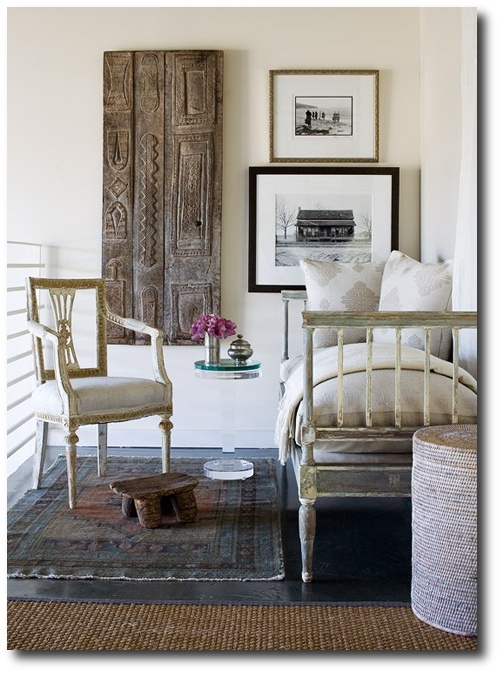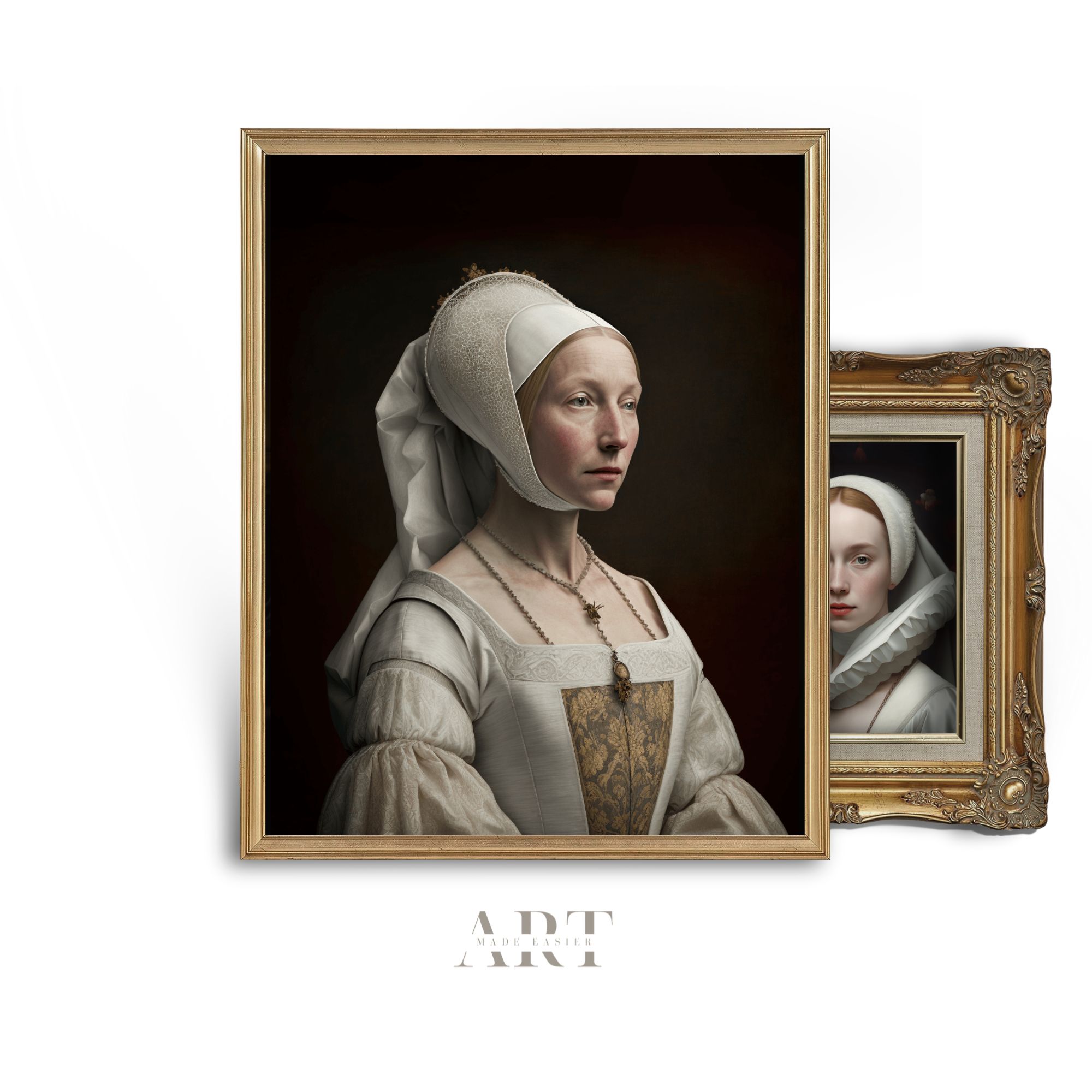Helen Olsen’s Rungstedlund Home Revealed In Gods & Gardar Magazine
After 17 years in Kenya, Danish author Karen Blixen returned to her childhood home in Rungstedlund, Denmark . The magazine Gods & Gardar reveal the history behind this magnificent property, where Danish elegance meets the drama of Africa.
“It was Karen’s father, Captain and author Wilhelm Dinesen who bought the property in 1879.
Two years later, after his marriage to Ingeborg Westenholz, the couple moved there and had five children, three daughters and two sons. Karen came to stay at Rungstedlund until age 28, except for two periods. The first period was the year the family had to leave Rungstedlund when the farm was restored after a fire in 1898. The second time Karen did Rungstedlund for a long time was when she studied art in Paris.”
“What makes Karen Blixen Rungstedlund so fascinating to visit is that the different rooms reflects two distinct phases of her life. For just as Karen packed some things from Rungstedlund before his trip to Africa, silver candelabras, English porcelain, Bohemian crystal and mahogany furniture, so she brought her most prized possessions, the essence of her Afrikaår, when she moved back to Denmark. On Rungstedlund intermingled memories of Africa still with antique family heirlooms, large carpets, delicate lace curtains, mahogany tables and furniture in the Louis Seize style and a Norwegian Rococo stove from in 1760.”
How To Combine African Elements Into Your Swedish Style
1. Keep the Architecture Nordic.
It is remarkable that Karen Blixen’s home looks both Scandinavian, and African at the same time. How did she pull it off? One of the ways the Scandinavian feel is so clearly evident is in the architecture. The framed walls are one of the hallmarks of the Nordic style. You don’t need several thousand dollars to get this look. One way of doing this is simply by adding some wood trim on the walls. To get Blixen’s look, spray paint your wood trim with gold paint, and finish it off with gold leaf.
Easy Gold Leafing- French Style Authority
Another way of adding architectural detail to your walls is to paint lines in shapes of boxes. A post that clearly shows this idea is Lars Sjoberg’s Swedish Gustavian Decorated House. In this post, you can clearly see lines painted on the walls, which gives the appearance of architectural trim. Where to start? If there is a door in the room, or windows, start with the box above the window or door.
2. Include A Few Moroccan Textures
In the dining area, Karen Blixen uses an area rug with a strong pattern. In this photo, moroccan floor tiles are used to create an entry way. The photo is quite close to Nordic design. A simple white is used on the walls, and the flooring gives this room the edge it needs. The gilt wood mirror gives this room a polished touch. An inexpensive way off adding the pattern into the room is to use throw pillows and tablecloths.
Royal Design Studio sells a moroccan stencil in a star diamond pattern. Consider stenciling your walls in a bright color found in Africa. Consider placing simple painted furniture with this pattern such as white furniture, or black painted furniture. With a white and orange pattern, white furniture can still work quite elegantly. Incorporate pine flooring, and add texture to the walls in natural wood, or metal such as what Karen did with her study.
3. Avoid Clutter.
One of the biggest mistakes people make is have too many accessories. Showcase your art, and draw attention to your furniture by having less accessories, and an open floor space. Even if you jam pack the furniture in, be sure that table tops don’t have dozens of ornaments. Reduce them, pair down, and donate pieces that simply just don’t work with the overall theme.
4. Incorporate The Colors Of Africa
The colors of Africa central around earth tones, such as brown, cream, rich greens, oranges, and reds. For example, you can work with these colors on the walls such Karen did for her home. If the dominant colors are the richer colors, consider toning down the room with a few natural wood pieces. White furniture would provide a rich contrast to the vibrant hues on the walls. If you choose to go with white walls, consider working with painted furniture, or heavily distressed furniture with the richer colors in the upholstery. Can you imagine, raw pine wood floors, with a white settee, gold accents, with burgundy upholstery? Perhaps throw in a rich red chest, and the room can take on the African flavor quickly. To include the Swedish style, pick upholstery fabrics with sweeping vertical lines, stripes or florals, or a combination of both.
6. Create A Wall Collection
Karen’s study is an excellent example of a collection that reflects the African culture. Collect African hand-made pottery, baskets, rugs, swords, plates, knives, but stay away from the masks, or statues which are involved in the ceremonial worship. Woven baskets are an ancient form of art in African culture. Typically crafted with simple geometric designs, African baskets will vary in design, making them great to decorate with.
Space is one of the main considerations when planning a wall based around objects or collections. Avoid a crowded or crammed look when using African wall decor, a little can go a long way. Placing too many items together can look messy, and give the idea that the look isn’t well thought out. Spacing your pieces, or collecting like objects, like a collection of baskets, or knives pays special attention to individual pieces.
Another designer trick is to place even tones together. Working with the color wheel will give you a great idea of the colors to work with, and those to avoid. Try to place the same colors, hues or tones together to give a more organized presentation. Metal, woods, and natural materials work with practically every color, although when working with china, or pottery, it helps to work with the color wheel, when placing items on a painted wall.
Picture Credits
- African Designer Catherine Raphaely
- Medieval Strong Box Ottoman $406
- British Plantation Chair $361
- Floral Bouquet Pedestal Table $185
- Medieval Cross Frame Arm Chair$350
- Grand Medallion Crescent Console Table $455
- African Designer Karen Roos
- Camellia Wall Console Table $229
- Chateau Marquee Occasional Fabric Arm Chair $588
- Mademoiselle Cezanne’s French Slipper Chair $244
- The Beaufort End Table $310
- The Scottish Country House by James Knox
- Early 19th Century Painted Swedish Mora Clock- Dated 1827-
- A nice small scaled Danish grandmother’s clock in the 18th century style made during the 1950’s
Swedish Style Traditional Home Magazine
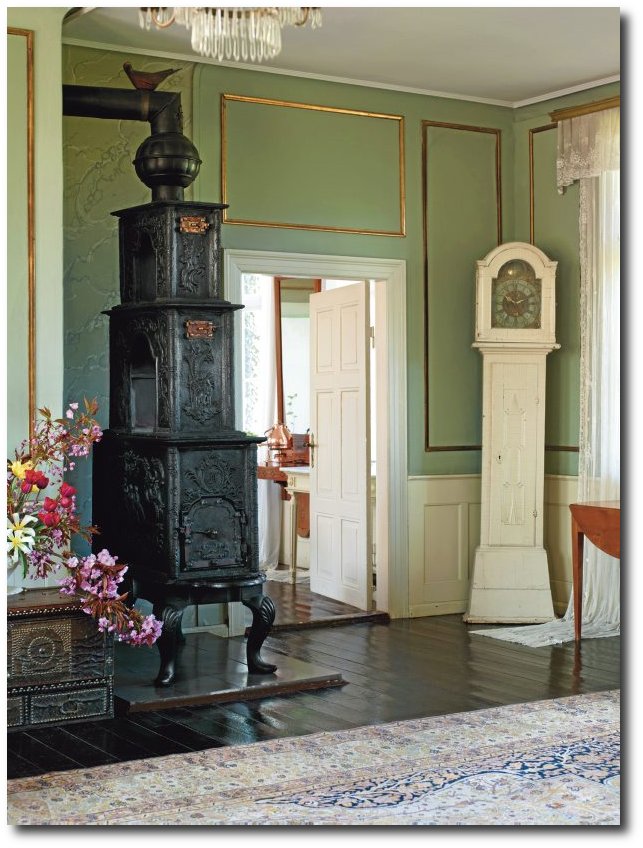
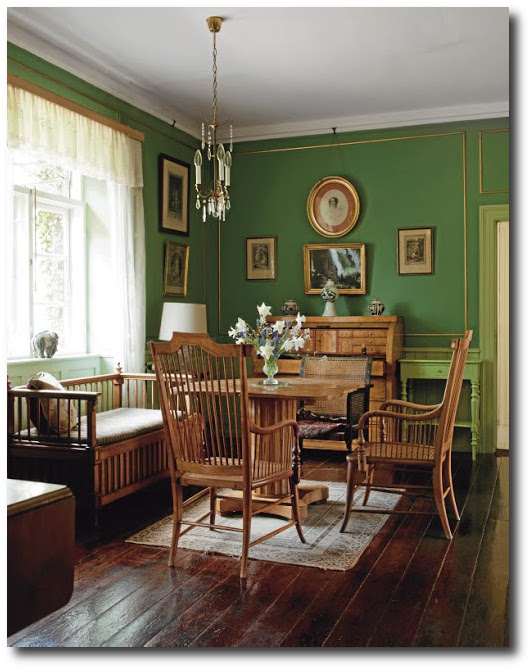


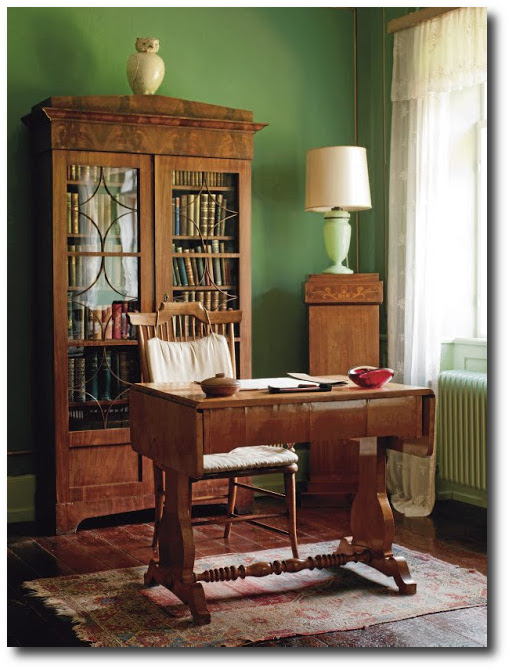

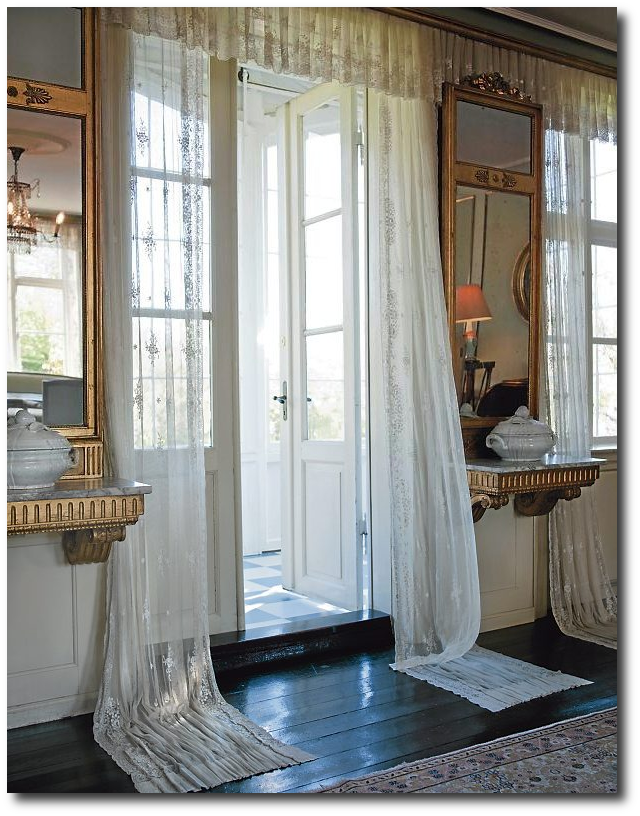
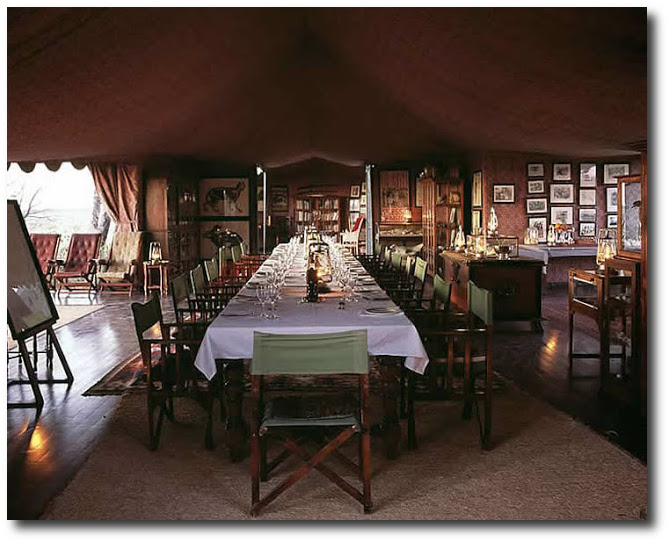
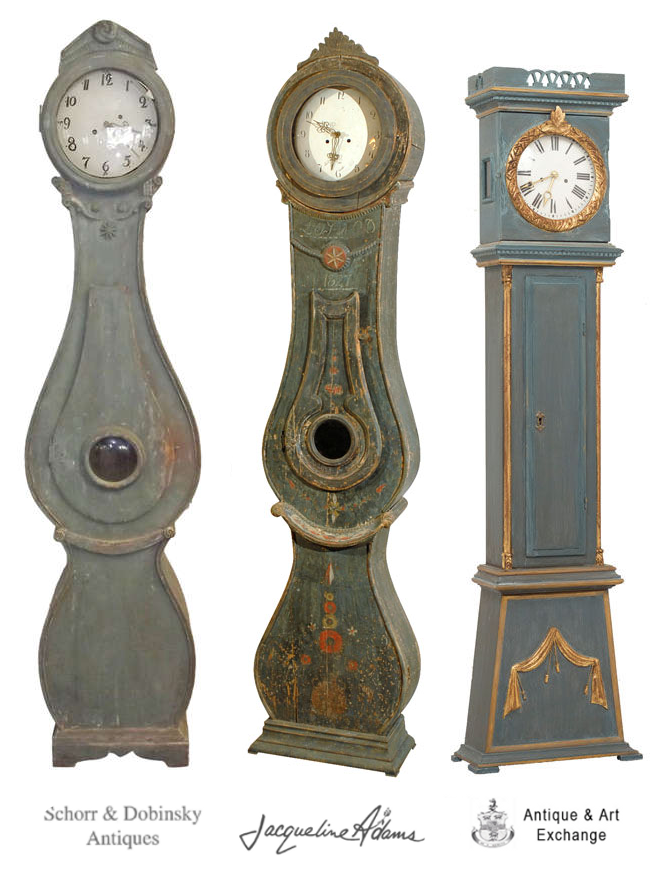

Quiet luxury inspired by 18th-century Sweden
Light - Patina - Heritage

Restoration Tools
- Matte Topcoat
- Pro Grade Brush Set
- Finishing Sealer In Matte
- Bronze Spray For Hardware
- Sticks To Everything Primer
- Dead Flat Varnish
- Stick To Everything - Matte Primer
- Transparent Aged Glaze
- Sticks To Everything Brown Primer
- Prima Transfers
- Dyke Brown Glaze
- Escutcheons
- Medallion Silicone Mold
- French Key Molds
- Portico Scroll
- Rusty Paint Finishes
Recent Posts
- 200 Swedish Antiques A Person Can Look For
- Rococo In The Nordic Countries
- For The Love Of Collecting Antiques – A Swedish Interior
- Gustavian Furniture – How to get the look – Ulla Kloster
- 3 Swedish Must Haves – Decorating A Home Around Swedish Antiques
- The Beautiful Wall Paintings Of von Echstedtska gården In Sweden
- 400 Professional Designers Picked Green As The New Color To Watch
- 5 Scandinavian Interior Design Tricks – Megan Slack
- 30 Gray Toned Paint Colors For Swedish Styled Interiors – Behr
- DIY Upper Kitchen Cabinets – Lindsay – White Buffalo Styling
- Bringing The Garden In For The Winter
- The Home Office – Why Not Make Yours Unique ?
- The Light And Airy Furniture Of Sweden
- Slipcovers Have Always Been Popular Through Time – Swedish Decorating
- The Couple Behind D. Larsson Interior and Antikhandel – Swedish Antiques
- 6 Colors You’ll Find In Every Scandinavian Home – Laura Barry
- 5 Decorating Mistakes Not To Make – By Gabrielle Savoie
- Designer Marshall Watson’s Scandinavian Newport Beach Home
- Designer Marshall Watson’s Scandinavian Summer House
- Swedish Inspired Kids Bedrooms
- 5 Kitchen Design Lessons You Can Learn from Scandinavian Interiors
- Jenny’s DIY Wide-Plank Plywood Flooring Studio Renovation
- Decor Mistakes All 20-Somethings Make
- Can I Stain Over Paint To Produce A Patina?
- Q&A With Swedish Designers Edie Van Breems and Rhonda Eleish
- How To Avoid Yellowed White Painted Furniture With General Finishes Products
- Colleen Martin, Founder of Swede Collection Tells Us Her Journey Of How She Began Reproducing Gustavian Furniture
- Expect To See More Warm Grays, Blues And Creams In Gustavian Decorating
- 8 Brands Of Gold Spray Paint Were Compared To Find The Best Color
- Essential Characteristics Of 18th Century Swedish Interiors
- Gustavian Style By Kristie Barnett
- 7 Places To Find Swedish Design For Toddlers
- Study Shows The Gustavian Period Has Defined All Tastes Through Time In Sweden
- Mix Old and New Like the Scandinavians Do- Chloe Taylor
- Swedish Furniture Design – What Makes The 1800’s So Obsessive
- 5 Pieces Of Wise Decorating Advice From Tricia Foley
- Impressive History Of Fine Swedish Table Linen
- Linen Has An Incredible History- Find Out Why……
- Life In 17th Century Norway & Sweden
- How To Select The Right Linen For Your Children’s Bedroom- Kids Room Decor Ideas
- Nordic Style Kids Bedroom Decor Ideas
- Decorator Tricia Foley’s Signature White Interiors
- 10 Tips From Interior Designer Furlow Gatewood
- Living In Norway- Norwegian Life In The 18th & 19th Centuries By Elisabeth Holte
- Investing In Mora Clocks – Expert Advice From Jo From Swedish Interior Design
- International Interior Decorating Magazines Worth Buying
- Swedish Council Of America Articles
- 5 Homes Decorated Around The Nordic Style
- Swedish Reproduction Furniture At Solgarden
- Behind The Rundale Palace in Latvia
- Nordic Style Historical Interior Decorating Books – Living Museums in Scandinavia
- Decorating Around Red- Historical Interior Design Ideas
- Florence De Dampierre Comments On Nordic Furniture In Sweden And Denmark
- 12 Designers Pick Their Favorite Paint Colors – House Beautiful
- 7 Of The Most Famous Swedish Furniture Designers And Decorators
- New Research Suggests Swedish Furniture In The 1700’s May Have Had Strong Colors
- Swedish Tripod Tilt-Top Candle Stand Tables
- Decorators Who Have Embraced The Nordic Style – 30+ Pictures
- A Look Behind Skogaholm Manor -18th century Swedish Decorating
- Decorating With Swedish Country Antiques- Darlene Peterson Buchanan
- 12 Interior Designers Pick Their Favorite Swedish Paint Colors
- 50+ Decorating Books Worth Looking At
- Swedish Decorating Inspirations In Yellow, Ivory And Beige- 50+ Pictures
- Decorating Around The Color Green – Swedish Style
- A Dallas, Texas Home Decorated Around The Swedish Style
- 3 Houses Decorated Around The Rustic Swedish Style
- Reproduction Distressed Furniture And Home Decor From Bliss Studio
- Buy The Swedish Style For Less
- 3 Swedish Style Homes Featured In Magazines
- Swedish Antiques From Debenham Antiques
- The History Behind Jean Bernadotte Otherwise Known As Karl Johan
- 5 Faux Wall Painting Techniques That Are Easier Than You Think
- Swedish Kids Rooms: 6 Ideas To Get The Look
- 5+ Nordic Homes Decorated Around White
- 10 Of The Best Tours In Sweden
- 3 Rustic Scandinavian Country Homes – Borrow Ideas From Norway and Denmark
- Spring Summer Checks and Florals For The Swedish Home
- 70 Swedish Furniture Pieces That Sell For Less- Swedish Decorating On A Budget
- Decorating With Blue: Swedish Style Decorating Ideas
- An Interview With Daniel Larsson- The Go-To Guy For Swedish Antiques
- 7 Scandinavian Country Decorating Books
- 75 Swedish Nordic Pinterest Pages! Oh Yes…More Eye Candy!
- 69 Inspiring Pictures Of Nordic Country Style Decorating
- 20 Scandinavian Gift Ideas
- 5 Ways To Add Life Into Worn-Out Furniture
- Mora Clocks: Investing In Swedish Heritage
- How To Decorate With Botanicals
- Buying Property In Sweden
- Get The Swedish Look By Installing Tongue And Groove Paneling
- The Lavish Interior Of The Swedish Häringe Castle
- The Swedish Wreta Gestgifveri Inn
- Paint It White He Says…. Washington Interior Designer Darryl Carter – Swedish Decorating
- 5 Pro Painting Tips For Black Furniture
- The Swedish Artist Carl Larsson
- A Guesthouse Decorated in The Swedish Style
- Swedish Furniture From Bukowski Market
- 216 Selections From Wallpaper Direct – Swedish Decorating
- A Look Behind The National Museum of Stockholm
- Antique Swedish Dealer Jane Moore’s Home Veranda Magazine
- A Swedish Collected Home In Upstate New York – Swedish Gustavian Decorating
- $100+ Solid Braided Rugs
- 60 Scandinavian Country Folk Art Books On Amazon
- 50 Examples Of Swedish Folk Country Interiors
- Designers Pick Their Favorite Gray Paints
- HOW TO: Paint Gustavian Finishes
- “Söderbo” A Home Untouched Since 1920
- Designer Martha Angus Loves Gustavian Style
- Les Indiennes Fabrics
- Decorating Secrets- 60 Quotes From The Best Experts In Design
- Swedish Kakelugn Stoves
- Helen Olsen’s Rungstedlund Home Revealed In Gods & Gardar Magazine
- The 1700 Collection Swedish Furniture
- Swedish Plaster Medallions
- The History Behind Empire Furniture From The Karl Johan Period -Liza Laserow
- Swedish Styled Wallpaper
- Nordic Style Drapery And Window Coverings
- The Gentle Palette of Swedish Antiques-Corey Amaro
- Custom Reproduction Swedish Furniture From Garbo Interiors
- 30 Spectacular Picks From Frantz Hemeleers Antiques
- Go Bold With Red- Part 1 Grand Sophisticated Interiors
- Go Bold With Red- Nordic Country Interiors
- The Baroque Style Of Switzerland
- Daniel Romualdez’s Swedish Montauk Home
- The Shocking History Behind “Emerald Green” Paint
- Stylish Looks For Slip-covering Your Furniture
- The Best 5 Websites For Purchasing Antique Hardware
- Fired Earth’s Anniversary Paint Collection
- Swedish Furniture Auctions -Uppsala Auktionskammare
- Louis Masreliez- The Designer Behind Gustav III’s Pavilion At Haga Park
- A Nordic Design Staple- The Swedish Kakelugn Tile Stove
- Swedish Antique Mirrors
- How To Decorate A Child’s Room In The Swedish Style
- Ruby Beets Swedish Rustic Home
- The Country Side Of Sweden- An All White Based Home
- Akerö in Södermanland, Sweden
- Krusenberg Herrgård: An 18th Century Swedish Luxury Hotel
- Wood Plank Flooring, A Swedish Design Must Have – Part 1
- Vinyl Plank Flooring, A Swedish Design Must Have – Part 2
- Laminate Wood Flooring, A Swedish Design Must Have – Part 3
- Plywood Plank Flooring, A Swedish Design Must Have – Part 4
- Painted Wood Flooring, A Swedish Design Must Have – Part 5
- The Romantic Baroque Style: Part 1- Stromholm
- The Romantic Baroque Style: Part 2 King Gustav Vasa
- The Romantic Baroque Style: Part 3 Skokloster & Steninge Palace
- The Romantic Baroque Style: Part 4 – A Collectors Home
- The Romantic Baroque Style: Part 5 Add Color
- Sweden’s Empire Decorated Rosersberg Palace
- The Most Beautiful Rococo Library In The World:The Anna Amalia Library
- 4 Resources For Swedish Decorating
- How Important Are Accent Pieces In A Swedish Home?
